Personality, Lifestyle, and Values
1/21
There's no tags or description
Looks like no tags are added yet.
Name | Mastery | Learn | Test | Matching | Spaced |
|---|
No study sessions yet.
22 Terms
Freudian Theory
Sigmund Freud: our adult personality stems from a fundamental conflict between our desires to gratify physical needs and the necessity to function as a responsible member of society
id > the “party animal”; maximize pleasure and avoid pain
superego > our conscience; internalizes society’s rules as taught to us
ego > the mediator; tries to balance opposing forces according to the reality principle (you have to do what you have to do “societally,” go to school/work, etc.)
- The system that acts as a referee between temptation and virtue, according to Freud, is called the ego
Neo-Freudian Theories
Work that has been influenced by Freud
Neo-Freudian Theories > scientists believe our personalities are more influenced by how we handle relationships with others
Archetypes
Archetypes: universally recognized ideas and behavior patterns
e.g., old wise men, Mother Nature
Brand Asset Archetypes model = proposes healthy and unhealthy relationships among archetypes
A healthy personality occurs when archetypes prevail
An unhealthy personality occurs when shadows prevail
How does this translate to brands?
Characteristics
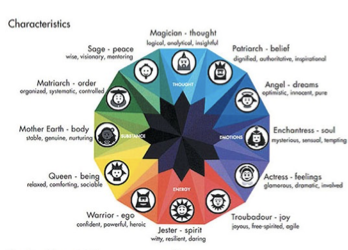
Shadow Characteristics
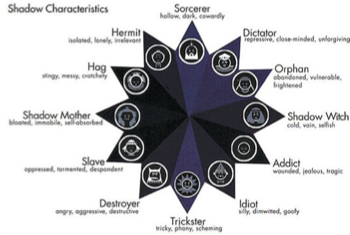
Trait Theory
Personality Traits: identifiable characteristics that define a person
Some crucial traits for marketing settings
Need for uniqueness
Need for affiliation
Introversion/Extroversion
Attention to social comparison information
Frugality
Mindset Media (Marketing Research Companies)
TV shows that you watch can offer marketers insights into your personality and brands you prefer
The Big Five (Personality Traits)
Most widely recognized approach to measuring personality traits
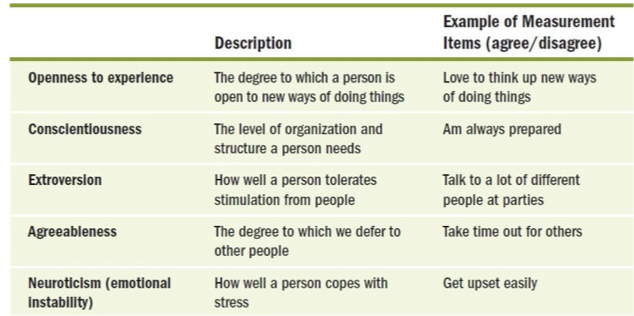
Personality Tests
Myers-Briggs Type Indicator = widely used personality test (especially by employers)
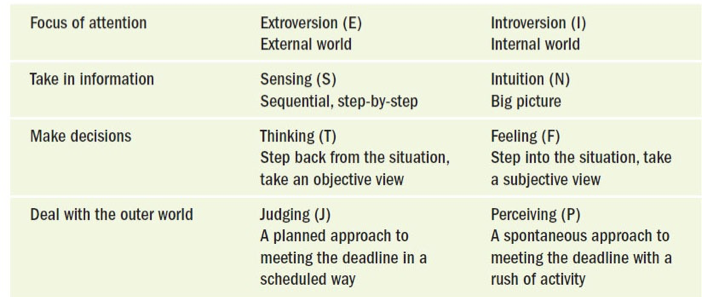
But…there are problems
It makes sense then that marketers would want to target products to consumers with specific personality traits
But, research methods have been met with mixed success
Perhaps it’s better to focus on…
Brand Personalities
Brand Personality: set of traits people attribute to a product as if it were a person
Brand Storytelling: emphasizes the importance of giving a rich background to involve consumers in the brand’s history or experience
One popular genre for brand storytelling is underdog brand biography
For any brand’s personality, authenticity is key
Common Brand Personalities
Sincerity – Liberty Mutual, State Farm
Excitement – Red Bull, Nike
Competence – Microsoft, Google
Sophistication – Audi
Ruggedness – Harley Davidson
Anthropomorphism
Anthropomorphism: tendency to attribute human characteristics to objects or animals
Strategies that make brands more anthropomorphic:
Speaking in the first person
Imitating human faces
Fictitious or real human names
Lifestyles
Lifestyle: a pattern of consumption that reflects a person’s choices on how to spend time and money
Marketers use the lifestyle marketing perspective,
recognize that people sort themselves into groups based on
What they like to do
How they like to spend their free time
How they choose to spend disposable income
A key aspect to lifestyle marketing is to focus on people who use products in desirable social settings
Product Complementarity & Co-Branding
It’s important to identify sets of products/services that consumers associate with a particular lifestyle
e.g., fast food and paper plates, suit and tie, Halloween costumes and candy
Co-branding strategies: companies work together to promote 2+ items
Sometimes a brands’ mascots will join forces in ads
Product complementarity: when symbolic meanings of different products relate to one another
Consumers use these sets of products to create a product constellation to define, perform, and communicate specific social roles
Psychographics
Psychographics: involves the use of psychological, sociological, and anthropological factors to determine how the market is segmented
Focus is on the reasons why an individual makes a particular decision about a product, person, ideology
Investigates consumers’ motivations for purchasing/using products
How are psychographics different from demographics?
Demographics tell us who buys and psychographics tell us why they buy
It is possible to use psychographics to identify distinct segments even for mundane products such as soap.
Psychographic Analysis
Most research attempts to group consumers according to some combination of activities, interests, and opinions > AIOs
First step if so determine which lifestyle segments yield the most customers for a product (think 80/20 rule)
What can marketers do with this information?
AIO Dimensions
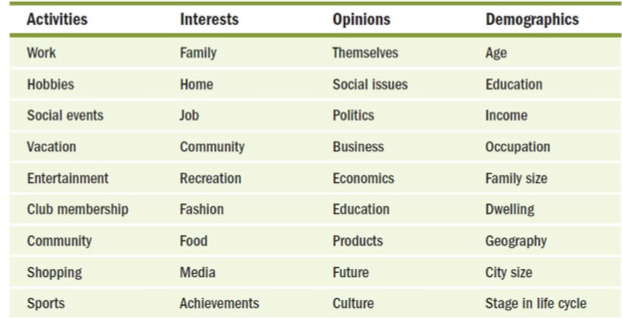
Values
Value: what is preferred over other alternatives
Two people can believe in and exhibit the same behaviors but for very different underlying belief systems
e.g., vegetarianism
We purchase items believing it will help us attain a value-related goal
Core Values
Some values are universal
e.g., health, wisdom, world peace
Value systems > different cultures have different rankings or relative importance to universal values
e.g., Western cultures value independence more and Eastern cultures value interdependence more
Each culture has a general set of core values that uniquely define the culture
e.g.,
We learn our own culture’s beliefs through enculturation
We learn about other cultures’ beliefs through acculturation
Norms
From values flow norms which tell us what is right or wrong, acceptable/unacceptable in our society
Encated Norms > norms that are explicit
e.g., the rule that green in a traffic light means go, red means stop
Crescive Norms > more subtle, discovered as we interact with others
Custom – controls basic behaviors
More – custom with a strong moral undertone (often involves taboo)
Convention – how we conduct our everyday lives (the “correct” way to host parties, style our clothes, furnish our place)
Culturally appropriate behavior
Each of the three crescive norms jointly define a culturally appropriate behavior
A more may tell us what food is okay to eat
A custom dictates when appropriate time to eat
Conventions tell us how to eat (i.e., table etiquette, utensils used)